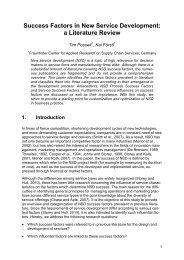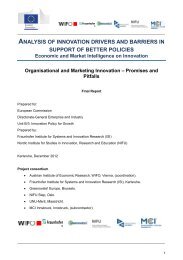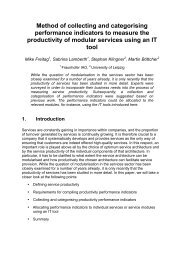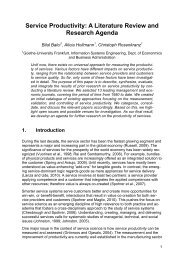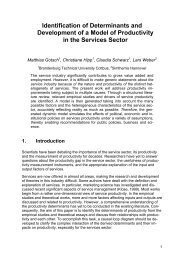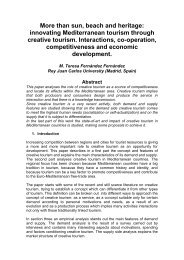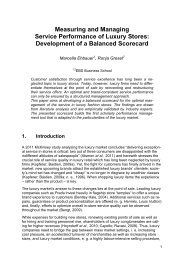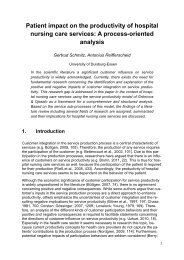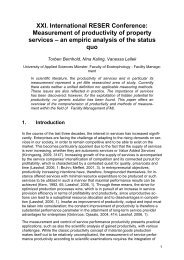The Productivity of Services: A systematic literature review - RESER ...
The Productivity of Services: A systematic literature review - RESER ...
The Productivity of Services: A systematic literature review - RESER ...
Create successful ePaper yourself
Turn your PDF publications into a flip-book with our unique Google optimized e-Paper software.
<strong>The</strong> <strong>Productivity</strong> <strong>of</strong> <strong>Services</strong>:<br />
A <strong>systematic</strong> <strong>literature</strong> <strong>review</strong><br />
Claudia Lehmann, Marcus Koelling<br />
HHL - Leipzig Graduate School <strong>of</strong> Management<br />
While a firm’s ability to pursue a productive orientation has been posited<br />
as having positive performance effects (Slack et al. 2007), little is currently<br />
known about the concept <strong>of</strong> productivity in the field <strong>of</strong> service research. To<br />
that end, this paper focuses on the <strong>literature</strong> on productivity, efficiency and<br />
effectiveness, published since 1989 and conducted a <strong>review</strong> with the purpose<br />
<strong>of</strong> determining if and what contributions have been done to service<br />
research. This study on service productivity draws upon the analysis <strong>of</strong> <strong>literature</strong><br />
from a <strong>systematic</strong> <strong>review</strong> perspective. <strong>The</strong> aim <strong>of</strong> this research is<br />
to adopt the <strong>systematic</strong> <strong>review</strong> approach <strong>of</strong> Tranfield et al. (2003) as a tool<br />
for highlighting an up-to-date landscape <strong>of</strong> the multifaceted dimensions <strong>of</strong><br />
service productivity.<br />
Introduction<br />
In this paper, we <strong>review</strong> the academic <strong>literature</strong> on the understanding <strong>of</strong> productivity,<br />
efficiency and effectiveness in the field <strong>of</strong> service research. During the last decade,<br />
the significance <strong>of</strong> service industries to the prosperity <strong>of</strong> modern economies has been<br />
widely recognized (Vuorinen et al. 1998). Academic interest in issues relating to service<br />
research is significantly growing. <strong>Productivity</strong>, although critical for the sustained<br />
success <strong>of</strong> service organizations, has received relatively little service specific attention<br />
as distinct from the more general phenomenon <strong>of</strong> productivity as the input to<br />
output relation (Johnston & Jones 2004). Generally, the productivity <strong>of</strong> a process is<br />
related to how effectively input resources are transformed into value for customers.<br />
For the needs <strong>of</strong> manufacturers, there are widely used productivity concepts and<br />
measurements instruments.<br />
This paper is devoted to taking steps toward closing three significant gaps in the <strong>literature</strong><br />
on productivity, efficiency and effectiveness and its contribution to service<br />
research. First, there has been inconsistent usage in terminology within service research.<br />
Labels such as productivity, efficiency and effectiveness are used in different<br />
ways by different scholars, resulting in a limited collective knowledge accumulation<br />
about service productivity. In response, we propose clear definitions for key terms to<br />
provide much-needed conceptual clarity that may help advance the <strong>literature</strong>. In doing<br />
so, we seek to provide a categorization <strong>of</strong> productivity, efficiency and effectiveness,<br />
which explicitly recognizes that there are different kinds <strong>of</strong> configurations and<br />
each <strong>of</strong>fers unique insights contributing to the field <strong>of</strong> service research. Second, there<br />
exists no published <strong>systematic</strong> <strong>literature</strong> <strong>review</strong> in the field <strong>of</strong> service productivity.<br />
1
Third, the use <strong>of</strong> the productivity concept beyond operations management theory has<br />
been very limited, despite the potential to shed new light on diverse phenomena. On<br />
this account, we develop future research ideas aimed at extending and defining productivity<br />
thinking within service theory.<br />
<strong>The</strong>oretical base<br />
<strong>The</strong> content <strong>of</strong> productivity<br />
<strong>The</strong> uniqueness <strong>of</strong> productivity research relative to other research approaches can<br />
be highlighted by considering how it pursues the goal <strong>of</strong> operations management.<br />
Generally, operations management aims at ensuring that business operations are<br />
efficient in terms <strong>of</strong> using as little resources as needed, and effective in terms <strong>of</strong><br />
meeting customer requirements (Markland et al. 1995). It is concerned with managing<br />
the process that converts inputs (in the forms <strong>of</strong> materials, labor and energy) into<br />
outputs (in the form <strong>of</strong> goods and services). Within this research area productivity is<br />
the most common measure <strong>of</strong> competitiveness (Russell & Taylor 2000). <strong>The</strong>refore,<br />
productivity is defined as the ratio <strong>of</strong> what is produced by an operation to what is required<br />
to produce it (Slack et al. 2007).<br />
<strong>The</strong> predominant input in productivity calculation is labor hours. According to the Bureau<br />
<strong>of</strong> Labor Statistics, even though labor is the only factor <strong>of</strong> production explicitly<br />
considered, comparisons <strong>of</strong> productivity over time implicitly reflect the joint effects <strong>of</strong><br />
many other factors, including technology, capital invest capacity utilization, energy<br />
use and managerial skills. Thus, productivity statistics provided in government reports<br />
typically measure changes in productivity from month to month, quarter to quarter,<br />
year to year or over a certain period (Russell & Taylor 2000). Operations management<br />
assumes that improving quality by reducing defects will increase outputs<br />
and reduce input. In fact, virtually all aspects <strong>of</strong> quality improvement have a favourable<br />
impact on different measures <strong>of</strong> productivity. Improving product design and production<br />
process, improving the quality <strong>of</strong> materials and parts, improving job design<br />
and work activity, they will all increase productivity (Russell & Taylor 2000).<br />
Problematic in this context is the general approach towards productivity as an umbrella<br />
concept including efficiency and effectiveness. In order to develop a model <strong>of</strong><br />
service productivity it is important to provide some clarity and distinction between<br />
these terms (Johnston & Jones 2004). Efficiency and effectiveness should be treated<br />
as related but separate concepts. Efficiency describes the degree to which an activity<br />
generates a given quantity <strong>of</strong> outputs with a minimum consumption <strong>of</strong> inputs, or generates<br />
the largest possible outputs from a given quantity <strong>of</strong> inputs (Johnston & Jones<br />
2004). Effectiveness, in turn, indicates the ability to attain a goal or a purpose. Effectiveness<br />
relates the output to the goal set for the operation, whereas efficiency relates<br />
the output to the resources used (input). Efficiency is about doing things right<br />
and effectiveness is about doing the right things. <strong>The</strong>re exists a clear distinction between<br />
effectiveness and productivity: effectiveness is tied to the ability <strong>of</strong> an organization<br />
to attain its specified objectives, whereas productivity concerns the relationship<br />
between outputs and inputs (Vuorinen et al. 1998). Despite its apparent benefits,<br />
the productivity function faced a series <strong>of</strong> critiques in the late 1980s. Blois argued<br />
2
that increasing productivity is not a sufficient condition for enhancing an organization’s<br />
effectiveness. In fact, productivity may be increased at the cost <strong>of</strong> effectiveness<br />
in meeting the goals set for the organization (Blois 1984). Efficiency is a common but<br />
loosely defined concept in the business disciplines. It may be seen as a quantitative<br />
(technical efficiency) or a value (economic efficiency) concept. Technical efficiency<br />
may be considered synonymous with productivity as a ratio between output and input,<br />
although efficiency has sometimes been defined as the inverse to productivity.<br />
When efficiency is defined in value terms, one tries to make compatible the effects <strong>of</strong><br />
various input and output factors in the production process (Grönross & Ojasalo<br />
2004). This interpretation has led to formulations in which efficiency is seen as costs<br />
per product. Technical efficiency and productivity may be defined as distinct concepts<br />
by taking the standard <strong>of</strong> comparison as a frame <strong>of</strong> reference: in the case <strong>of</strong> a productivity<br />
ratio, the aim is to compare the output-input ratios across units and time,<br />
whereas in the case <strong>of</strong> an efficiency ratio, the comparison is made against a predetermined<br />
standard or ideal. If a meaningful interpretation can be given to ideal performance,<br />
it is reasonable to perceive an efficiency ratio as an indicator <strong>of</strong> the extent<br />
to which actual performance has achieved the ideal level (overall efficiency) or the<br />
best observed performance (Frei & Harker 1999). According to the basic principle <strong>of</strong><br />
economic rationality, the purpose is to achieve a given result with minimal resources<br />
or to get the maximum result with a given set <strong>of</strong> resources. However, given the variety<br />
<strong>of</strong> definitions that describe performance in the production <strong>of</strong> services, we assume<br />
that comprehensive understanding is needed. Given the importance <strong>of</strong> the productivity<br />
concept to scholars and service organizations, there is a need to summarize extant<br />
knowledge about this concept as the foundation for setting the stage for further<br />
advances.<br />
<strong>The</strong> content <strong>of</strong> services<br />
While comparing productivity between service and manufacturing operations, one <strong>of</strong><br />
the basic claims has been that the special characteristics <strong>of</strong> services demand a more<br />
holistic approach including a customer-orientation to productivity (Blois 1984). More<br />
specifically, several researchers have argued that quality and productivity cannot be<br />
dealt with separately in the case <strong>of</strong> services (Djellal & Gallouj 2008) (Grönross &<br />
Ojasalo 2004). Despite the emergence <strong>of</strong> productivity as a central concept for service<br />
researchers, little agreement exists about the definition and nature <strong>of</strong> service productivity<br />
(Nachum 1999a) (Anderson et al. 1997). Consequently, there seems to be a<br />
growing need for a thorough analysis <strong>of</strong> the productivity concept in the context <strong>of</strong><br />
services.<br />
Whereas the bulk <strong>of</strong> traditional service research has mainly focused on the identification<br />
<strong>of</strong> characteristic differences between goods and service (Lovelock 1991a), recently<br />
the goods dominant logic considers services as type <strong>of</strong> (intangible) goods,<br />
which implies differences between tangible goods and services in terms <strong>of</strong> production<br />
and distribution practices (Vargo & Lusch 2008), (Vargo & Lusch 2004).<br />
<strong>Productivity</strong> as a concept is used to manage production efficiency in manufacturing.<br />
In services, for example, due to the nature <strong>of</strong> service production processes as open<br />
systems and the participation <strong>of</strong> customers in those processes, such a productivity<br />
concept is too limited (Grönross & Ojasalo 2004). Normally, only measurements <strong>of</strong><br />
partial productivity are obtained and no control <strong>of</strong> the overall productivity and its effects<br />
on the economic results <strong>of</strong> the service provider and on customer value is exer-<br />
3
cised. What appears to be improved productivity in terms <strong>of</strong> better production efficiency<br />
may turn out to have a negative effect on perceived service quality, customer<br />
value and, in the final analysis, on the economic result <strong>of</strong> the firm (Ojasalo 2003) (Parasuramam<br />
2002).<br />
<strong>Services</strong> are carried out in an organizational setting, which always refers to embodied<br />
and especially emotional situations (Küpers 1998). This influence <strong>of</strong> embodiments,<br />
emotions and the phenomenological significance <strong>of</strong> ways <strong>of</strong> expression on<br />
the service productivity has not been a key focus in service productivity research so<br />
far (Lassh<strong>of</strong> 2006) (Gummesson 1998). <strong>The</strong>refore, the complexity <strong>of</strong> the relationship<br />
between service provider and customer can be identified as an essential characteristic<br />
<strong>of</strong> service processes (Ojasalo 2003). Rather than specifying a single type <strong>of</strong> relationship<br />
from the service providers perspective the service process can be divided<br />
into three separate processes (Grönross & Ojasalo 2004).<br />
• producing the service in isolation (back <strong>of</strong>fice);<br />
• producing the service in interaction with the customer (service encounter);<br />
• the customer produces the service in isolation from the service provider (using<br />
the provided infrastructure only).<br />
Thus, all participants involved in either kind <strong>of</strong> these service processes are first and<br />
foremost embodied beings, who are embedded in a specific service system. <strong>The</strong><br />
most fundamental way in which service providers are involved concerning these service<br />
systems is their perceptual interaction. Especially the perceived quality and image<br />
<strong>of</strong> service companies depend on the engagement and performance <strong>of</strong> the service<br />
providers (Verbeke 2004) (Grandey et al. 2002).<br />
<strong>The</strong> problems <strong>of</strong> using a traditional productivity concept in services discussed above<br />
and highlighted the necessity <strong>of</strong> developing a productivity concept, which is geared<br />
towards the nature <strong>of</strong> services. Managing productivity should be seen as a mutual<br />
learning experience, where the service provider and the customer are aligning their<br />
resources and production and consumption processes to each other. In summary, it<br />
can be said that measuring productivity as an efficiency issue may be less appropriate<br />
in services but rather to see service productivity as a pr<strong>of</strong>itability concept.<br />
Given the importance <strong>of</strong> the service productivity concept to organizations, there is a<br />
need to summarize extant knowledge about this concept as the foundation for setting<br />
the stage for further advances. <strong>The</strong>refore, it is crucial to identify the existing <strong>literature</strong><br />
on service productivity to shed some light onto the complex field <strong>of</strong> service productivity.<br />
In order to achieve this aim we conducted a <strong>systematic</strong> <strong>literature</strong> <strong>review</strong>, which<br />
consolidates past accomplishments and to sets the stage for future developments.<br />
4
Systematic Literature Review<br />
Methodology<br />
In order to fully map the prior research in the field <strong>of</strong> service productivity, we conducted<br />
a <strong>systematic</strong> <strong>literature</strong> <strong>review</strong>. As mentioned above the traditional ‘narrative’<br />
<strong>review</strong>s <strong>of</strong>ten lack rigor and in many cases are not undertaken with the required accuracy<br />
(Pittaway et al. 2004) (Marr et al. 2003). In this study, we applied a method<br />
similar to that described in Tranfield et al. (2003), which uses the principles <strong>of</strong> <strong>systematic</strong><br />
<strong>review</strong> methodology that are used in medical science in order to counteract<br />
bias and produce transparent. It is also applicable for high-quality and relevant <strong>literature</strong><br />
<strong>review</strong>s in management research.<br />
Conducting a <strong>systematic</strong> <strong>review</strong> means adopting a replicable, scientific and transparent<br />
process, minimizing the bias through exhaustive <strong>literature</strong> searches <strong>of</strong> published<br />
and unpublished studies and providing an audit trail <strong>of</strong> the <strong>review</strong>ers decisions, procedures<br />
and conclusions (Cook et al. 1997). Thus, it is very important to ensure that<br />
the <strong>review</strong> is both methodical and replicable.<br />
<strong>The</strong>refore, this <strong>systematic</strong> <strong>review</strong> will follow the three stages outlined by Tranfield et<br />
al. (2003): First planning the <strong>review</strong>; second conducting the <strong>review</strong> and third reporting<br />
and dissemination. <strong>The</strong> overall process <strong>of</strong> the <strong>review</strong> is summarized in Fig. 1.<br />
Defining the<br />
objectives<br />
Descriptive reporting<br />
<strong>of</strong> citations<br />
Step A: Planningthe <strong>review</strong><br />
Preparing the<br />
proposal<br />
Step B: Conducting the <strong>review</strong><br />
Step C: Reporting the <strong>review</strong><br />
<strong>The</strong>matic reporting<br />
<strong>of</strong> journal articels<br />
Developing the<br />
protocol<br />
Stage One Stage Two<br />
Stage Three Stage Four<br />
Activity<br />
Define search words<br />
used for coverage <strong>of</strong><br />
database<br />
Define time period for<br />
search<br />
Activity<br />
Selection <strong>of</strong><br />
biographical databases<br />
Activity<br />
Filtering <strong>of</strong> the articles<br />
Activity<br />
Analysis <strong>of</strong> the articles<br />
Fig. 1: Summary <strong>of</strong> the <strong>systematic</strong> <strong>review</strong> process (following (Thorpe et al. 2005))<br />
5
Step A: Planning the <strong>review</strong><br />
Prior to the beginning <strong>of</strong> the <strong>review</strong>, a <strong>review</strong> panel was formed with experts in the<br />
areas <strong>of</strong> both <strong>review</strong> methodology and theory. <strong>The</strong> <strong>review</strong> panel helped to direct the<br />
process through regular meetings and resolved upcoming disputes over the inclusion<br />
and exclusion <strong>of</strong> studies.<br />
Defining the objectives and preparing the proposal<br />
At the beginning <strong>of</strong> the <strong>systematic</strong> <strong>literature</strong> <strong>review</strong> stood an iterative process <strong>of</strong> definition,<br />
clarification, and refinement. <strong>The</strong>refore, it was important to the authors and<br />
<strong>review</strong>ers to consider cross-disciplinary perspectives and alternative ways in which<br />
the research topic has been tackled previously. This first overview included a brief<br />
summary <strong>of</strong> the theoretical, practical and methodological history debates surrounding<br />
the field service productivity.<br />
Developing the protocol<br />
<strong>The</strong> protocol for any <strong>literature</strong> <strong>review</strong> ought to contain a conceptual discussion <strong>of</strong> the<br />
research problem and a statement <strong>of</strong> the problem's significance rather than a defined<br />
research question (Tranfield et al. 2003). <strong>The</strong> aim is to produce a protocol that does<br />
not, on the one hand, interfere the researcher's ability to be creative in the <strong>literature</strong><br />
<strong>review</strong> process, but, on the other hand, ensure that the <strong>review</strong> is less open to researcher<br />
bias than a more traditional narrative <strong>review</strong>s (Tranfield et al. 2003) (Phelps<br />
et al. 2007). Condensed a <strong>systematic</strong> <strong>review</strong> enables scholars to provide an audit<br />
trail <strong>of</strong> search terms and reasons for including/excluding articles (Lee 2009).<br />
Step B: Conducting the <strong>review</strong><br />
Stage one: Define search words and time period<br />
<strong>The</strong> <strong>systematic</strong> search began with the identification <strong>of</strong> keywords, regarding the productivity<br />
<strong>of</strong> services on the scoping <strong>literature</strong> study and on their prior experience. <strong>The</strong><br />
list <strong>of</strong> keywords was completed in a brainstorming session with other academic researchers<br />
and afterwards grouped into search strings. A search string is by definition<br />
a list <strong>of</strong> root concepts and key words linked by operators such as AND or OR. <strong>The</strong><br />
following list shows the used search terms, which were linked by the Boolean operator<br />
OR:<br />
• productiv* / productivity / productiveness<br />
• effectiveness / efficiency<br />
• outcome / performance / capability / fruitfulness<br />
• measur* / measurement / meter / gauging<br />
<strong>The</strong> search with this root search string was always accomplished in connection with<br />
service*(through Boolean phrase AND).<br />
To cover an appropriate time period all scholarly articles from January 1989 until<br />
June 2010 were considered.<br />
6
Stage two: Selection <strong>of</strong> biographical databases<br />
A number <strong>of</strong> key bibliographical databases were selected for this search: EBSCOhost;<br />
ABI Proquest; Business Source Premier; Science Direct; Web <strong>of</strong> Science (ISI<br />
Web <strong>of</strong> Knowledge); JSTOR database and Emerald. <strong>The</strong> database with the greatest<br />
coverage coupled to functionality and full article access were: EBSCOhost and Web<br />
<strong>of</strong> Science (ISI Web <strong>of</strong> Knowledge). <strong>The</strong>se bibliographical databases were chosen<br />
and <strong>review</strong>ed using the search strings identified in step one. <strong>The</strong>refore, the search<br />
was conducted in title, abstract and keyword search.<br />
Stage three: Filtering <strong>of</strong> the articles<br />
<strong>The</strong> results <strong>of</strong> a first search, conducted at the EBSCOhost database with the search<br />
string in the defined time period, lead to 92148 hits. In order to assess the relevance<br />
and size <strong>of</strong> the <strong>literature</strong> and to state clearly the focus <strong>of</strong> the research study, the<br />
scope <strong>of</strong> the <strong>literature</strong> <strong>review</strong> process have to be delimited further by other factors.<br />
Tranfield et al. (2003) state regarding this problem: “…management researchers<br />
usually rely on the implicit quality rating <strong>of</strong> a particular journal, rather than formally<br />
applying any quality assessment criteria to the articles they include in their <strong>review</strong>s<br />
(i.e. refereed journals are 'better' than practitioner journals)…”. So the initial assessment<br />
criteria for including studies into the <strong>literature</strong> <strong>review</strong> were: the specifically relation<br />
to services, theoretical and empirical studies, quantitative and qualitative studies<br />
and studies which were published in academic or high quality business journals. To<br />
estimate the quality <strong>of</strong> journals the ranking <strong>of</strong> the German Academic Association for<br />
Business Research (VHB) has been used. <strong>The</strong> ranking <strong>of</strong> the journals are subdivided<br />
in different groups. In order to the relevance <strong>of</strong> the research theme the <strong>review</strong> team<br />
decided to conduct the search in all Journals ranked A to D in two groups “General<br />
business studies” and “Service and Trade Management”. <strong>The</strong>se two subgroups cover<br />
together a range <strong>of</strong> 80 journals.<br />
<strong>The</strong> conducted search elicited over 3250 references. Evaluating the title and abstract<br />
<strong>of</strong> the publications by relevance (present <strong>of</strong> service productivity) and the teams ‘a<br />
priori’ knowledge enabled the team to reject approximately 2900 articles. <strong>The</strong> <strong>review</strong>ers<br />
then looked independently the remaining papers and further reduced the<br />
amount to a list <strong>of</strong> 56 relevant studies in the end. <strong>The</strong>se studies were cross-checked<br />
by the reference section, which led to a list <strong>of</strong> 104 additional studies. <strong>The</strong>se were <strong>review</strong>ed<br />
again independently and 24 studies were included in the <strong>literature</strong> <strong>review</strong>.<br />
Before accepting a paper into the <strong>review</strong> the authors checked for repeated studies to<br />
ensure there is no duplication; for example if the same study is published in two different<br />
journals with different first authors, only one study would be included in the<br />
<strong>review</strong>; usually the most comprehensive study or the most recent study. <strong>The</strong> different<br />
stages involved in the selection process are shown in Table 1.<br />
7
Selection Process Nb. studies<br />
Studies extracted from database
Sources <strong>of</strong> publications<br />
<strong>The</strong> total amount <strong>of</strong> the 74 as relevant identified articles was published in 31 academic<br />
journals. Of which the majority (46%) were found in four academic journals.<br />
<strong>The</strong>refore, 19% <strong>of</strong> the articles were published in the Service Industries Journal, 15%<br />
in the International Journal <strong>of</strong> Service Industry Management, 7% in the Management<br />
Science and 5% in the Journal <strong>of</strong> Business Research.Table 1 gives a breakdown <strong>of</strong><br />
where the 74 articles are published.<br />
Data Source Nb. <strong>of</strong> articles<br />
Service Industries Journal 14<br />
International Journal <strong>of</strong> Service Industry Management 11<br />
Management Science 5<br />
Journal <strong>of</strong> Business Research 4<br />
Other 40<br />
Table 2: Publication sources <strong>of</strong> included articles (34 out <strong>of</strong> 74 articles are published in 4 journals)<br />
Type <strong>of</strong> study<br />
Fig. 3 shows that out <strong>of</strong> the 80 studies, 61% are empirical, i.e. findings are based on<br />
direct evidence or experiment. <strong>The</strong> 25% theoretical or conceptual studies are based<br />
on an understanding <strong>of</strong> the field from experience or reference to other related work.<br />
Only a smaller number <strong>of</strong> studies (14%) are either <strong>review</strong>s <strong>of</strong> <strong>literature</strong> (11%) or reports<br />
(3%).<br />
theoretical/<br />
conceptual<br />
25%<br />
report<br />
3%<br />
Fig. 3: Types <strong>of</strong> studies in accepted papers<br />
<strong>review</strong><br />
11%<br />
empirical<br />
61%<br />
Data collection methods used in the empirical studies include: surveys and questionnaires,<br />
field studies, structured interviews, case studies, focus groups and data <strong>review</strong>s.<br />
9
Out <strong>of</strong> the 48 empirically studies 57% base on secondary data or re-examine empirical<br />
work <strong>of</strong> other authors just 20 studies (43%) base on primary data (see Fig. 3). In<br />
this primary studies different research strategies, such as quantitative (45%), qualitative<br />
(40%) and mixed approaches (15%), where used.<br />
secondary<br />
studies;<br />
57%<br />
Fig. 4: Data origin in empirical studies<br />
primary<br />
studies;<br />
43%<br />
Geographical and service sector distribution <strong>of</strong> papers<br />
<strong>The</strong> papers <strong>review</strong>ed are also analyzed according to the countries that feature within<br />
the studies. This analysis shows that a high percentage <strong>of</strong> the empirical studies are<br />
concentrated on work carried out in the USA (25%) and the United Kingdom (19%),<br />
as shown in Fig. 5: Countries represented in the empirical studies. One study even<br />
compares the productivity <strong>of</strong> different service sectors in different time periods in the<br />
UK to the USA [23]. Overall most countries, except the USA, the United Kingdom, the<br />
Scandinavian countries and Spain, are not well represented. Thus, it is clear that<br />
when we synthesize findings from all these studies we are giving a predominantly<br />
Western view <strong>of</strong> the productivity <strong>of</strong> services.<br />
Nb. <strong>of</strong> studies<br />
12<br />
11<br />
10<br />
9<br />
8<br />
7<br />
6<br />
5<br />
4<br />
3<br />
2<br />
1<br />
0<br />
Fig. 5: Countries represented in the empirical studies<br />
10
<strong>The</strong> industrial focus <strong>of</strong> the studies included is presented in Fig. 6. <strong>The</strong> sample <strong>of</strong> studies<br />
in the <strong>review</strong> is more or less balanced toward the different service sectors. In<br />
particular the finance sector (banks and accounting), tourism sector (hotels, travel<br />
agents and tour operators) and the retail service (grocery stores and fast food restaurant)<br />
have been the object <strong>of</strong> investigation. However, most studies (31%) cover and<br />
compare multiple service sectors.<br />
Nb. <strong>of</strong> Studies<br />
16<br />
14<br />
12<br />
10<br />
8<br />
6<br />
4<br />
2<br />
0<br />
Multiple<br />
service<br />
sectors<br />
Fig. 6: Service sectors analysis <strong>of</strong> studies <strong>review</strong>ed<br />
Consulting Finance Health ICT Public<br />
Sector<br />
Retailer Tourism<br />
In summary, a number <strong>of</strong> key points can be made for the conducted <strong>review</strong>. First, the<br />
evidence based <strong>of</strong> this <strong>literature</strong> <strong>review</strong> is somewhat dominated by empirical studies.<br />
<strong>The</strong>refore, the empirical studies are mostly based on secondary data. <strong>The</strong> methodologies<br />
<strong>of</strong> productivity measurement are diverse. Primarily, the following two techniques<br />
are used: Index measurement and linear programming. <strong>The</strong> most prevalent<br />
concept, within the index measurement, is the Total Factor <strong>Productivity</strong>. Basically this<br />
model proposes measuring productivity as a ratio <strong>of</strong> output to different inputs (Craig<br />
& Harris 1973). <strong>The</strong> approach <strong>of</strong> linear programming constructs a production frontier<br />
and evaluates each input’s contribution to the productive process based on past performance<br />
data. <strong>The</strong> most prevalent programming technique used in the <strong>review</strong>ed<br />
studies is the Data Envelope Analysis (DEA). DEA is a flexible, non-parametric estimation<br />
procedure which identifies the contribution <strong>of</strong> a set <strong>of</strong> inputs for achieving the<br />
maximum quantities <strong>of</strong> a given set <strong>of</strong> outputs. This approach does not require price<br />
data on inputs and products, quantities <strong>of</strong> inputs can be directly utilized (Banker et al.<br />
1989) (Norman & Stoker 1991) (Sherman 1984). In particular 27% <strong>of</strong> all empirical<br />
studies and yet 44% <strong>of</strong> all studies based on secondary data have been evaluated by<br />
a data envelopment analysis. <strong>The</strong> disadvantages <strong>of</strong> DEA are two-fold. First, it requires<br />
a fairly large series <strong>of</strong> data so that the optimization can be estimated with a<br />
more general set <strong>of</strong> benchmarks. Second, being a non-stochastic procedure, tests <strong>of</strong><br />
statistical significance are harder to develop (Singh et al. 2000).<br />
Furthermore, many studies (9%) concerning the “<strong>Productivity</strong> Paradox <strong>of</strong> Information<br />
Technology”. This phenomenon describes the situation in which large investment into<br />
communication technology has not led to productivity gains (Nachum 1999b). In the<br />
short run, increased input devoted to the acquisition <strong>of</strong> new knowledge decreases<br />
productivity because the productivity measure reflects increased input without a corresponding<br />
increase in output (Lehr & Lichtenberg 1998).<br />
11
Finally, the research to date lacks some depth in terms <strong>of</strong> the very limited number <strong>of</strong><br />
studies based on primary data. <strong>The</strong> research is also fragmented as it is spread<br />
across a large number <strong>of</strong> authors, journals and disciplines. <strong>The</strong> main conclusion,<br />
which can be drawn from the sample used in this <strong>systematic</strong> <strong>literature</strong> <strong>review</strong>, is that<br />
the subject area requires some prioritization by a ‘critical mass’ <strong>of</strong> academics over a<br />
prolonged period if the evidence base is to be improved and expanded.<br />
Step C: Reporting the <strong>review</strong><br />
Finally, a <strong>systematic</strong> <strong>review</strong> should make it easier for academics and practitioner to<br />
understand the research by synthesizing extensive primary research papers from<br />
which it was derived (Tranfield et al. 2003).<br />
<strong>The</strong>refore, the presented database should be used to highlight the up-to-date landscape<br />
<strong>of</strong> the multifaceted dimensions <strong>of</strong> service productivity in the next step. On that<br />
account the report <strong>of</strong> the <strong>literature</strong> <strong>review</strong> should be structured as follows: First, the<br />
existing theoretical approaches should be <strong>review</strong>ed and be reflected in an overview.<br />
Second, the term <strong>of</strong> service productivity should be conceptualized in order to explore<br />
the extent <strong>of</strong> influencing factors and interdependencies on the productivity <strong>of</strong> services.<br />
Finally, managerial implications and key issues for the management <strong>of</strong> service<br />
productivity should be summarized.<br />
<strong>The</strong>oretical Lenses in Service <strong>Productivity</strong> Research<br />
Researchers studying service productivity have drawn on a wide range <strong>of</strong> theoretical<br />
lenses commonly used in service research. <strong>The</strong> following section summarizes the<br />
most common theories used in service productivity research. In many studies, researchers<br />
chose to integrate two or more theoretical lenses to examine the issue under<br />
study.<br />
We summarize the key features <strong>of</strong> each conceptual article in Appendix 1. When <strong>review</strong>ing<br />
conceptual articles, we examined the theoretical base as well as capturing<br />
an understanding <strong>of</strong> how the work contributes to knowledge about the service productivity<br />
concept. Research in service productivity has been criticized for lacking adequate<br />
theoretical bases (Shafti et al. 2007) (Grönross & Ojasalo 2004); however, we<br />
found that research surrounding the service productivity construct is theoretically rich,<br />
embracing a multitude <strong>of</strong> theories, including knowledge management theory, resourced<br />
based management capacity theory, relationship theories and operations<br />
theory. Our <strong>review</strong> <strong>of</strong> conceptual works suggests that the service productivity construct<br />
holds a great promise as basis for theory building. For example, Drucker<br />
(1991) developed a theory <strong>of</strong> knowledge circles and productivity development. Such<br />
approaches could be used to build theory on other service productivity-related<br />
processes, such as knowledge management for employees and clients. Anticipatory,<br />
other forms <strong>of</strong> theory building can be used to move this research stream forward. For<br />
example, the productivity output depends on capacity management, quality management,<br />
and resource productivity or efficiency management (Armistead & Clark<br />
1994) and is related to the Penrose assumption (1954) <strong>of</strong> management capacity. Different<br />
definitions <strong>of</strong> service productivity in the <strong>literature</strong> (i.e., intellectual capabilities<br />
(Quinn et al. 1996) vs. dependency <strong>of</strong> service-good combinations (Reichwald &<br />
Möslein 1995) vs. phenomenology/expression (Küpers 1998) vs. client-service provider<br />
interaction (Gummesson 1998)/(Parasuramam 2002) may be an appropriate<br />
aspects to creating new theory.<br />
12
Adding another aspect to existing conceptual frameworks to develop more complex<br />
theoretical models is another fruitful avenue for future research. For example, Klassen<br />
et al. (1998) show, that productivity measurement in concert with efficiency measurements<br />
provides a stronger basis for evaluation than using productivity alone.<br />
<strong>The</strong>y suggest that efficiency and productivity measures may have less meaning in<br />
services in which transaction size may not accurately reflect the value <strong>of</strong> the service<br />
(e.g. financial service). Another possibility is considering how client activities (e.g.,<br />
time, quality and value added inputs) can moderate service productivity (Martin et al.<br />
2001). <strong>The</strong>refore service productivity highly depends on customer knowledge, experience<br />
and motivation (Ojasalo 2003). Johnston & Jones (2004) argue that it is important<br />
to understand the relationship between operational and customer productivity. In<br />
their model customer productivity includes satisfaction as one output variable. Other<br />
authors like Anderson et al. (1997) or Gummesson (1998) have separated service<br />
quality or satisfaction from productivity. Hence, (Grönross & Ojasalo 2004) define<br />
service productivity as a function <strong>of</strong> internal efficiency; external efficiency and capacity<br />
efficiency. In their model service productivity is defined as total revenues <strong>of</strong> the<br />
service divided by total costs <strong>of</strong> the service. A third possibility is building a theoretical<br />
framework for understanding and analyzing the productivity <strong>of</strong> service workers in a<br />
system. Dobni (2004) argues that service productivity is most likely to be improved if<br />
it is managed in a <strong>systematic</strong> way. Given this approach, Das, Sidhartha R.; Canel<br />
(2006) show that the designing <strong>of</strong> a service process might be the foundation for improving<br />
service productivity.<br />
From a strategic perspective (Djellal & Gallouj 2010) identified three generic service<br />
productivity strategies: First, assimilation strategies achieve productivity gains by<br />
making the service as tangible as possible and minimize the degree <strong>of</strong> interaction<br />
with the customer. Second, differentiation strategies try to implement rationalizations<br />
methods for services (e.g. standardization, formalization <strong>of</strong> procedures and routines).<br />
Third, integration strategies combine these two strategies by using a variety <strong>of</strong> arrangements.<br />
13
Conclusion<br />
We started this article by noting the importance <strong>of</strong> service productivity in today’s<br />
business landscape. <strong>The</strong> service productivity phenomenon is a relatively new research<br />
area in the widely researched field <strong>of</strong> operations management and service<br />
research, and researchers from different domains have started to address a broad<br />
set <strong>of</strong> research questions through a wide range <strong>of</strong> theoretical lenses, leading to a<br />
certain level <strong>of</strong> fragmentation <strong>of</strong> the service productivity <strong>literature</strong>. Most <strong>of</strong> the articles<br />
were published between 2004 till 2006. <strong>The</strong> objectives <strong>of</strong> this article were to <strong>review</strong><br />
the existing service productivity research, organize major findings by key research<br />
areas, and develop a research agenda by identifying existing gaps in the present understanding<br />
and highlighting future research opportunities.<br />
<strong>The</strong> <strong>review</strong> <strong>of</strong> the service productivity <strong>literature</strong> suggested that the existing body <strong>of</strong><br />
research can be organized around a conceptual map comprising different major research<br />
areas each representing important aspects. <strong>The</strong>se areas are knowledge<br />
management, operations management, management capacity/resource based perspective,<br />
customer/client perspective and system and interaction perspective. <strong>The</strong>refore,<br />
we argue it is important to understand the perspective <strong>of</strong> operational and customer<br />
productivity and the relationship in between. Although the interest among<br />
service scholars in the service productivity phenomenon has grown significantly in<br />
the past few years, many <strong>of</strong> the theoretically and empirically relevant and interesting<br />
issues in these three research areas have not yet been investigated or have only<br />
been addressed peripherally. Although the intention <strong>of</strong> this research effort was to<br />
present a complete as possible <strong>review</strong>, there are some limitations to this study. Most<br />
important, the <strong>literature</strong> search process was somewhat driven by a specific focus on<br />
service productivity and not productivity in general. Nevertheless, we are confident<br />
that this <strong>review</strong> covers the majority <strong>of</strong> the studies that are at the core <strong>of</strong> the research<br />
issues related to service productivity. We summarize that the contribution <strong>of</strong> this article<br />
rests in three areas: (a) the development <strong>of</strong> a conceptual map <strong>of</strong> the service<br />
productivity <strong>literature</strong> comprising different research areas, (b) a <strong>review</strong> <strong>of</strong> the existing<br />
service productivity research and discussion <strong>of</strong> major findings in each key research<br />
area, and (c) the development <strong>of</strong> an agenda for future research. Overall, the relatively<br />
new field <strong>of</strong> service productivity represents an exciting and promising area <strong>of</strong> research<br />
that is rich <strong>of</strong> further research opportunities.<br />
14
Appendix 1<br />
Author<br />
(Year)<br />
Drucker<br />
(1991)<br />
Colin./ Graham,<br />
(1994)<br />
Reichwald./<br />
Möslein<br />
(1995)<br />
Quinn./<br />
Anderson/<br />
Finkelstein,<br />
(1996)<br />
Küpers<br />
(1998)<br />
Referring<br />
theories<br />
(Chase & Bowen<br />
1991);<br />
(Heskett et al.<br />
1990);<br />
(Lovelock &<br />
Young 1979);<br />
(Rhyme 1988)<br />
(Brynjolfsson<br />
1991);<br />
(Picot &<br />
Gründler 1995)<br />
Definition <strong>of</strong> Service <strong>Productivity</strong><br />
Raising the productivity <strong>of</strong> knowledge and service work is<br />
essential.<br />
According to all the experience we have, the resulting<br />
productivity increases will equal, if not exceed, whatever<br />
industrial engineering, scientific management, or human<br />
relations ever achieved in manufacturing. In other words,<br />
they should give us the productivity revolution we need in<br />
knowledge and service work.<br />
Operations managers in a service organization will either<br />
succeed or fail in the process <strong>of</strong> balancing quality <strong>of</strong> service<br />
and resource management, expressed in terms <strong>of</strong><br />
resource productivity, depending on their skill in managing<br />
capacity to match demand.<br />
<strong>The</strong>re is an interaction between capacity management,<br />
quality management, and resource productivity or efficiency<br />
management which is at the heart <strong>of</strong> the planning<br />
and control process for operations management in services.<br />
<strong>The</strong> productivity <strong>of</strong> industrial services and the provision <strong>of</strong><br />
goods are interdependent factors. <strong>The</strong>y are the result <strong>of</strong><br />
rationalization processes which were concentrated only<br />
on the production <strong>of</strong> goods.<br />
Hence, the comparison between developments <strong>of</strong> productivity<br />
in manufacturing and services is characterized by<br />
<strong>systematic</strong> distortions.<br />
<strong>The</strong> productivity <strong>of</strong> a modern corporation or nation lies<br />
more in its intellectual and systems capabilities than in its<br />
hard assets.<br />
Intellectual and information processes create most <strong>of</strong> the<br />
value-added for firms in the large service industries.<br />
<strong>The</strong> extension <strong>of</strong> expressing feelings like sympathy, joy,<br />
satisfaction, dissatisfaction, embarrassment, influences<br />
the productivity <strong>of</strong> the service process in an essential<br />
way.<br />
In order to work out how emotions play a key role in organizational<br />
and customer-related activities, a phenomenology<br />
<strong>of</strong> working life is required.<br />
15
Gummesson<br />
( 1998)<br />
Klassen/<br />
Russell/<br />
Chrisman,<br />
(1998)<br />
Martin/<br />
Horne/<br />
Chan<br />
(2001)<br />
Parasuraman<br />
(2002)<br />
(Lovelock &<br />
Young 1979);<br />
(McLaughlin &<br />
C<strong>of</strong>fey 1990)<br />
(Siegel 1980);<br />
(Chase &<br />
Aquilano 1992);<br />
(Krajewski &<br />
Ritzman 1993);<br />
(Armistead et al.<br />
1988)<br />
(Lovelock 1991b);<br />
(Schneider 1980)<br />
Focus on the relationships between service providers<br />
and customers as these stand out in the service encounter<br />
and the service production process<br />
<strong>Productivity</strong> is a ration between output and input. <strong>The</strong><br />
more we can reduce the input keeping up output, the<br />
better is our productivity<br />
Measurements <strong>of</strong> productivity are <strong>of</strong>ten ambiguous and<br />
inadequate.<br />
<strong>Productivity</strong> measurement in concert with efficiency<br />
measurement, providing a stronger basis for evaluation<br />
than using productivity alone.<br />
<strong>Productivity</strong> cannot be defined by only one measure,<br />
but may include any measure relating output value to<br />
input value<br />
An overall productivity measure for individual firms is<br />
usually defined as output value/ input value with outputs<br />
and inputs measured in dollars.<br />
To meet the needs <strong>of</strong> individual operating units in a<br />
firm, adjustments can be made by calculating productivity<br />
<strong>of</strong> various input and output factors.<br />
Focus on client productivity as any measure <strong>of</strong> service<br />
productivity must include some component that focuses<br />
on the client side <strong>of</strong> the service encounter.<br />
Client productivity defined. In this context, high ”client<br />
productivity'' can be regarded as timely, quality and<br />
value-added inputs (e.g. data diagnosis or critical decisions)<br />
made to consulting projects for transformation <strong>of</strong><br />
such into achievement <strong>of</strong> preset common objectives<br />
(other things being constant).<br />
Conceptual framework for understanding the interlinkages<br />
among service quality and the various components<br />
<strong>of</strong> the company-customer perspective <strong>of</strong> productivity<br />
Definition productivity from the customer’s perspective<br />
defined as the ratio <strong>of</strong> the service output experienced<br />
by a customer to the inputs provided by that customer<br />
in service production.<br />
16
Ojasalo<br />
(2003)<br />
Johnston/<br />
Jones<br />
(2004)<br />
Grönroos/<br />
Ojasalo<br />
(2004)<br />
Dobni<br />
(2004)<br />
(Fuchs 1968);<br />
(Lovelock &<br />
Young 1979);<br />
(Bateson 1985);<br />
(Grönroos 1990);<br />
(Ojasalo 1999)<br />
(Johnston 1989);<br />
(Lovelock &<br />
Young 1979);<br />
(Martin et al.<br />
2001)<br />
(Chase & Haynes<br />
2000)<br />
(Blumberg<br />
1994)<br />
Service productivity is strongly connected with the customer<br />
participation in the service process.<br />
Customer are not a passive recipient <strong>of</strong> service providers<br />
output but an integrated part <strong>of</strong> the organization<br />
Service productivity highly depends on customers’<br />
knowledge, experience and motivation.<br />
Distinction between “operational productivity” and “customer<br />
productivity”<br />
<strong>The</strong>y argue that a major gap in our knowledge is in understanding<br />
the relationships between operational and<br />
customer productivity.<br />
(It should be noted that most authors separate out service<br />
quality or satisfaction from productivity (for example,<br />
Anderson et al., 1997; Gummesson, 1998) their<br />
notion <strong>of</strong> customer productivity however includes satisfaction<br />
as one output variable.)<br />
A service productivity concept can be defined in the<br />
following way: Service productivity = f (internal efficiency;<br />
external efficiency; capacity efficiency)<br />
Service productivity and quality should not be managed<br />
as separate processes. (costs <strong>of</strong> producing this service):<br />
As a global productivity measure <strong>of</strong> the operations <strong>of</strong> a<br />
service provider, the following measure can be used:<br />
Improving productivity in services requires a focus both<br />
on internal operational performance and external marketing<br />
so that the search for efficiency can be balanced<br />
against effectiveness from a marketing point <strong>of</strong> view.<br />
Service productivity is most likely to be improved if it is<br />
managed in a systemic way.<br />
17
Das/ Canel,<br />
(2006)<br />
Djellal/<br />
Gallouj<br />
(2010)<br />
<strong>Productivity</strong> as process objective that are derived from<br />
the overall organizational objectives.<br />
Design <strong>of</strong> service processes = foundation for improving<br />
overall customer service, service quality, and productivity<br />
<strong>The</strong> design <strong>of</strong> service processes begins with a statement<br />
<strong>of</strong> process objectives that are derived from the overall<br />
organizational objectives. <strong>The</strong>se process objectives may<br />
include customer service, service quality, productivity,<br />
etc.<br />
Three generic service productivity strategies:<br />
First, assimilation strategies achieve productivity gains by<br />
making the service as tangible as possible and minimize<br />
the degree <strong>of</strong> interaction with the customer.<br />
Second, differentiation strategies try to implement rationalizations<br />
methods for services.<br />
Third, integration strategies combine these two strategies<br />
by using a variety <strong>of</strong> arrangements.<br />
18
References<br />
Anderson, E.W., Fornell, C. & Rust, R.T., 1997. Customer satisfaction, productivity,<br />
and pr<strong>of</strong>itability: Differences between goods and services. Marketing Science,<br />
16(2), 129-145.<br />
Armistead, C. & Clark, G., 1994. <strong>The</strong> “Coping” Capacity Management Strategy<br />
in <strong>Services</strong> and the Influence on Quality Performance. International Journal <strong>of</strong> Service<br />
Industry Management, 5(2), 5-22.<br />
Armistead, C., Johnston, R. & Slack, N., 1988. <strong>The</strong> Strategic Determinants <strong>of</strong><br />
Service <strong>Productivity</strong>. International Journal <strong>of</strong> Operations and Production Management,<br />
8(3), 95-108.<br />
Banker, R., Charnes, A. & Cooper, W., 1989. An introduction to data envelopment<br />
analysis with some <strong>of</strong> its models and their uses. In J. Chan & J. Patton Research<br />
in governmental and nonpr<strong>of</strong>it Accounting. London: Jai Press, pp. 125-164.<br />
Bateson, J., 1985. Self service consumer: An exploratory study. Journal <strong>of</strong> Retailing,<br />
61(3), 49-75.<br />
Blois, K.J., 1984. <strong>Productivity</strong> and Effectiveness in Service Firms. <strong>The</strong> Service<br />
Industries Journal, 4(3), 49-60.<br />
Blumberg, D., 1994. Strategies for Improving Field Service Operations <strong>Productivity</strong><br />
and Quality. <strong>The</strong> Service Industries Journal, 14(2), 262-277.<br />
Brynjolfsson, E., 1991. <strong>The</strong> <strong>Productivity</strong> <strong>of</strong> Information Technology: Review<br />
and Assessment.<br />
Chase, R. & Aquilano, N., 1992. Production and Operations Management:<br />
ALife Cycle Approach 6.th., Homewood, IL: Richard D. Irwin, Inc.<br />
Chase, R. & Haynes, R., 2000. Service Operations Management. In T. Swartz<br />
& D. Iacobucci Handbook <strong>of</strong> services marketing and management. Thousand Oaks,<br />
CA: Sage Publications, pp. 455-72.<br />
Chase, R.B. & Bowen, D.E., 1991. Service Quality an the Service Delivery<br />
System. In S. Brown et al. Service Quality: Multidisciplinary and Multinational Perspectives.<br />
Massachusetts, Toronto: Lexington Books.<br />
Cook, D.J., Mulrow, C.D. & Haynes, R.B., 1997. Systematic Reviews: Synthesis<br />
<strong>of</strong> Best Evidence for Clinical Decisions. Annuals <strong>of</strong> Internal Medicine, 126(5), 376-<br />
380.<br />
Craig, C. & Harris, C., 1973. Total productivity measurement at the firm level.<br />
Sloan Management Review, 14(3), 13-28.<br />
Das, Sidhartha R.; Canel, C., 2006. Designing service processes: a design<br />
factor based process model. International Journal <strong>of</strong> <strong>Services</strong> Technology & Management,<br />
7(1), 85 - 107.<br />
19
Djellal, F. & Gallouj, F., 2008. Measuring and Improving <strong>Productivity</strong> in <strong>Services</strong>.<br />
Issues, Strategies and Challenges, Northampton: Edward Elgar.<br />
Djellal, F. & Gallouj, F., 2010. <strong>Services</strong>, Innovation and Performance. Journal<br />
<strong>of</strong> Innovation Economics, 1(5), 5 - 15.<br />
Dobni, D., 2004. A marketing-relevant framework for understanding service<br />
worker productivity. Journal <strong>of</strong> <strong>Services</strong> Marketing, 18(4), 303-317.<br />
Drucker, P.F., 1991. <strong>The</strong> New <strong>Productivity</strong> Challenge. Harvard Business Review,<br />
69(6), 69-79.<br />
Frei, F.X. & Harker, P.T., 1999. Measuring the Efficiency <strong>of</strong> Service Delivery<br />
Processes. Journal <strong>of</strong> Service Research, 1(4), 300-312.<br />
Fuchs, V., 1968. <strong>The</strong> service economy.<br />
Grandey, A.A., Tam, A.P. & Brauburger, A.L., 2002. Affective States and<br />
Traits in the Workplace: Diary and Survey Data From Young Workers. Motivation and<br />
Emotion, 26(1), 31-55.<br />
Grönroos, C., 1990. Service management and marketing, Lexington: Lexington<br />
Books.<br />
Grönross, C. & Ojasalo, K., 2004. Service productivity: Towards a conceptualization<br />
<strong>of</strong> the transformation <strong>of</strong> inputs into economic results in services. Journal <strong>of</strong><br />
Business Research, 57, 414 - 423.<br />
Gummesson, E., 1998. <strong>Productivity</strong>, quality and relationship marketing in service<br />
operations. International Journal <strong>of</strong> Contemporary Hospitality Management,<br />
10(1), 4-15.<br />
Heskett, J., Sasser, W. & Hart, C., 1990. Service Breaktroughs, New York:<br />
Free Press.<br />
Johnston, R. & Jones, P., 2004. Service productivity: Towards understanding<br />
the relationship between operational and customer productivity. International Journal<br />
<strong>of</strong> <strong>Productivity</strong> and Performance Management, 53(3), 201-213.<br />
Johnston, R., 1989. <strong>The</strong> customer as employee. International Journal <strong>of</strong> Operations<br />
& Production Management, 9(5), 104-12.<br />
Klassen, K., Russell, R. & Chrisman, J., 1998. Efficiency and <strong>Productivity</strong><br />
Measures for High Contact <strong>Services</strong>. <strong>The</strong> Service Industries Journal, 18(4), 1-18.<br />
Krajewski, L. & Ritzman, L., 1993. Operations Management: Strategy and<br />
Analysis 3rd., USA: Addison-Wesley Publishing Company.<br />
Küpers, W., 1998. Phenomenology <strong>of</strong> embodied productivity in services. International<br />
Journal <strong>of</strong> Service Industry Management, 9(4), 337-358.<br />
Lassh<strong>of</strong>, B., 2006. Produktivität von Dienstleistungen. Mitwirkung und Einfluss<br />
des Kunden., Wiesbaden: Deutscher Universitäts-Verlag.<br />
Lee, R., 2009. Social Capital and Business and Management: Setting a Research<br />
Agenda. International Journal <strong>of</strong> Management Reviews, 11(3), 247-273.<br />
20
Lehr, W. & Lichtenberg, F.R., 1998. Computer use and productivity growth in<br />
US Federal Goverment Agencies, 1987-92. Journal <strong>of</strong> Industrial Economics, XLVI(2),<br />
257-280.<br />
Lovelock, C.H. & Young, R.F., 1979. Look at consumers to increase productivity.<br />
Harvard Business Review, 57(3), 168-78.<br />
Lovelock, C.H., 1991. <strong>Services</strong> Marketing, Engelwood Cliffs, NJ: Prentice Hall.<br />
Lovelock, C.H., 1991. <strong>Services</strong> marketing 2. ed., Englewood Cliffs, N.J.: Prentice-Hall.<br />
Markland, R.E., Vickery, S.K. & Davis, R.A., 1995. Operations Management.<br />
Concepts in Manufacturing and <strong>Services</strong>, Saint Paul: West Publishing Company.<br />
Marr, B., Gray, D. & Neely, A., 2003. Why do firms measure their intellectual<br />
capital? Journal <strong>of</strong> Intellectual Capital, 4(4), 441-464.<br />
Martin, C.R., Horne, D.A. & Chan, W.S., 2001. A perspective on client productivity<br />
in business-to- business consulting services. International Journal <strong>of</strong> Service<br />
Industry Management, 12(2), 137-157.<br />
McLaughlin, C. & C<strong>of</strong>fey, S., 1990. Measuring productivity in services. International<br />
Journal <strong>of</strong> Service Industry Management, 1(1), 46-64.<br />
Nachum, L., 1999. Measurement <strong>of</strong> productivity <strong>of</strong> pr<strong>of</strong>essional services:An illustration<br />
on Swedish management consulting firms. International Journal <strong>of</strong> Operations<br />
& Production Management, 19(9), 922-949.<br />
Nachum, L., 1999. <strong>The</strong> <strong>Productivity</strong> <strong>of</strong> Intangible Factors <strong>of</strong> Production: Some<br />
Measurement Issues Applied to Swedish Management Consulting Firm. Journal <strong>of</strong><br />
Service Research, 2(2), 123-137.<br />
Norman, M. & Stoker, B., 1991. Data Envelopment Analysis: <strong>The</strong> Assesment<br />
<strong>of</strong> Performance, New York: Wiley.<br />
Ojasalo, K., 1999. Conceptualizing productivity in services, Helsinki: Swedish<br />
School <strong>of</strong> Economics and Business Administration.<br />
Ojasalo, K., 2003. Customer influence on service productivity. SAM Advanced<br />
Management Journal, 68(3), 14-19.<br />
Parasuramam, A., 2002. Service quality and productivity: a synergistic perspective.<br />
Managing Service Quality, 12(1), 6-9.<br />
Phelps, R., Adams, R. & Bessant, J., 2007. Life cycles <strong>of</strong> growing organizations:<br />
A <strong>review</strong> with implications for knowledge and learning. International Journal <strong>of</strong><br />
Management Reviews, 9(1), 1-30.<br />
Picot, A. & Gründler, A., 1995. Deutsche Dienstleister scheinen von IT nur<br />
wenig zu pr<strong>of</strong>itieren. Computerwoche, 10, 10-11.<br />
Pittaway, L. et al., 2004. Networking and innovation: a <strong>systematic</strong> <strong>review</strong> <strong>of</strong><br />
the evidence. International Journal <strong>of</strong> Management Reviews, 5/6(3/4), 137-168.<br />
21
Quinn, B., Anderson, P. & Finkelstein, S., 1996. Leveraging intellect. Academy<br />
<strong>of</strong> Management Executive, 10(3), 7-27.<br />
Reichwald, R. & Möslein, K., 1995. Wertschöpfung und Produktivität von<br />
Dienstleistungen? Innovationsstrategien für die Standortsicherung,<br />
Rhyme, D., 1988. <strong>The</strong> Impact <strong>of</strong> Demand Management on the Service System<br />
Performance. Service Industries Journal, 8(4).<br />
Russell, R.S. & Taylor, B.W., 2000. Operations Management. Third Edition,<br />
Upper Saddle River, New Jersey: Prentice Hall.<br />
Schneider, B., 1980. <strong>The</strong> service organization: climate is crucial. Organizational<br />
Dynamics. AMACOM, 52-65.<br />
Shafti, F., Van Der Meer, R. & Williams, T., 2007. An Empirical Approach to<br />
Service Classification for <strong>Productivity</strong> Management Studies. <strong>The</strong> Service Industries<br />
Journal, 27(6), 709-730.<br />
Sherman, H., 1984. Improving the productivity <strong>of</strong> service businesse. Sloan<br />
Management Review, 25(3).<br />
Siegel, I., 1980. Company <strong>Productivity</strong>: Measurement for Improvement, Michigan.<br />
Upjohn Institute for Employment Research: Kalamazoo.<br />
Singh, H., Motwani, J. & Kumar, A., 2000. A <strong>review</strong> and analysis <strong>of</strong> the state<strong>of</strong>-the-art<br />
research on productivity measurement. Industrial Management & Data Systems,<br />
100(5), 234-241.<br />
Slack, N., Chambers, S. & Johnston, R., 2007. Operations Management. Fith<br />
Edition, Harlow: Pearson Education.<br />
Thorpe, R. et al., 2005. Using knowledge within small and medium-sized firms:<br />
A <strong>systematic</strong> <strong>review</strong> <strong>of</strong> the evidence. International Journal <strong>of</strong> Management Reviews,<br />
7(4), 257-281.<br />
Tranfield, D., Denyer, D. & Smart, P., 2003. Towards a Methodology for Developing<br />
Evidence-Informed Management Knowledge by Means <strong>of</strong> Systematic Review*.<br />
British Journal <strong>of</strong> Management, 14, 207-222.<br />
Vargo, S. & Lusch, R., 2008. From goods to service(s): Divergences and convergences<br />
<strong>of</strong> logics. Industrial Marketing Management, 37(3), 254 - 259.<br />
Vargo, S.L. & Lusch, R.F., 2004. <strong>The</strong> Four Service Marketing Myths: Remnants<br />
<strong>of</strong> a Goods-Based, Manufacturing Model. Journal <strong>of</strong> Service Research, 6(4),<br />
324-335.<br />
Verbeke, W., 2004. <strong>The</strong> Adaptive Consequences <strong>of</strong> Pride in Personal Selling.<br />
Journal <strong>of</strong> the Academy <strong>of</strong> Marketing Science, 32(4), 386-402.<br />
Vuorinen, I., Järvinen, R. & Lehtinen, U., 1998. Content and measurement <strong>of</strong><br />
productivity in the service sector: A conceptual analysis with an illustrative case from<br />
the insurance business. International Journal <strong>of</strong> Service Industry Management, 9(4),<br />
377-396.<br />
22
Authors<br />
Claudia, Lehmann, Dipl.-Wi.-Ing.<br />
HHL - Leipzig Graduate School <strong>of</strong> Management<br />
Center for Leading Innovation & Cooperation (CLIC)<br />
Jahnallee 59 | 04109 Leipzig | GERMANY<br />
claudia.lehmann@hhl.de<br />
Marcus, Koelling, Dr.<br />
HHL - Leipzig Graduate School <strong>of</strong> Management<br />
Center for Leading Innovation & Cooperation (CLIC)<br />
Jahnallee 59 | 04109 Leipzig | GERMANY<br />
marcus.koelling@hhl.de<br />
We agree that the submitted paper is published as Working paper.<br />
23



